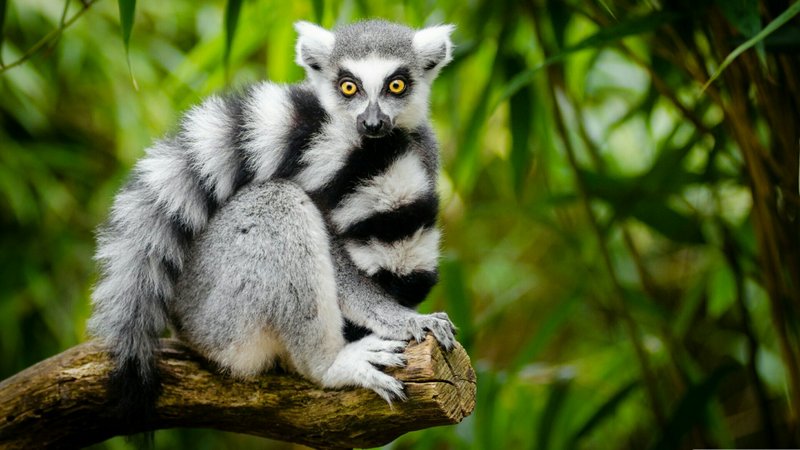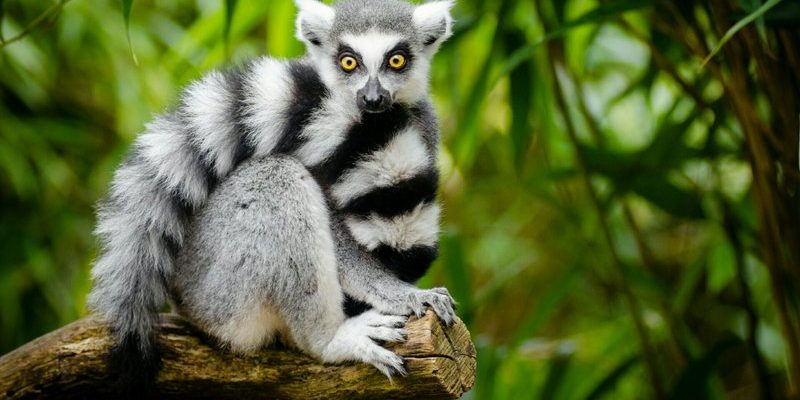
Just like how every sibling in a family can have distinct traits yet still share common features, many animals mirror the ring-tailed lemur in various ways. They might share habitats, behavioral traits, or even physical features. So grab a cup of coffee (or tea, whichever you prefer), and let’s explore this fascinating world of animal cousins. We’ll break down ten animals that are similar to the ring-tailed lemur and highlight what sets each one apart.
1. Sifaka
The sifaka is another member of the lemur family, native to Madagascar, just like its ring-tailed counterpart. Sifakas are known for their incredible leaping abilities, which is quite the spectacle! Instead of moving on all fours, they bounce from tree to tree in what looks like a graceful dance.
You might be wondering how to tell a sifaka apart from a ring-tailed lemur. While both creatures boast long tails, sifakas have a distinct white and brown coloration with a furry face—almost as if they’re wearing a little hat! They also have a unique way of moving; when they hop, it looks like they’re gliding through the air, making them truly special.
2. Indri
Meet the indri, one of the largest lemurs out there! These fascinating animals have a more robust build than ring-tailed lemurs and lack tails altogether. Picture a rounder body and a wide face, which gives them a rather cute appearance.
Indris are also unique in their vocalizations. If you’ve ever heard their eerie, haunting calls echoing through the forests of Madagascar, you know it’s unforgettable. Their calls serve as communication to locate one another, making them quite the vocal showstoppers compared to the more playful behaviors of ring-tailed lemurs.
3. Aye-Aye
Here’s where it gets interesting: the aye-aye is quite the oddball of the lemur family! It’s known for its long, thin middle finger, which it uses to tap on trees and locate insects. This finger looks a bit creepy, but it’s perfectly adapted for its role.
In contrast to the ring-tailed lemur’s social and playful nature, aye-ayes are more solitary. Their dark fur and large, bulging eyes give them a mysterious vibe, making them look like creatures straight out of a fantasy novel. But their similarity lies in being nocturnal and both residing in Madagascar, though their lifestyles are worlds apart.
4. Galago (Bush Baby)
If you thought lemurs were adorable, wait until you hear about galagos, or bush babies! These small primates are like the mini versions of lemurs, with big eyes and large ears. They’re agile jumpers, using those powerful hind legs to soar from tree to tree, much like lemurs.
What sets them apart is their size; galagos are significantly smaller than ring-tailed lemurs. Those big eyes help them see well in the dark since they’re primarily nocturnal. Their cute cries and movements make them charming little creatures; honestly, you might have trouble not falling in love with them!
5. Tarsier
The tarsier is another small primate but hails from Southeast Asia. These little guys feature enormous eyes, perfect for nighttime adventures. While tarsiers aren’t related to lemurs, they share a whole lot of similar behaviors, like being arboreal (tree-dwelling) and nocturnal.
Unlike ring-tailed lemurs, tarsiers have a much more solitary lifestyle. Their unique ability to rotate their heads almost 180 degrees gives them an edge in spotting predators. So, while they may not have stripes or the same social flair, they’re definitely fascinating cousins in the primate family tree.
6. Cotton-Top Tamarin
Let’s talk about the adorable cotton-top tamarin! These tiny primates boast a wild tuft of white fur on their heads, giving them a distinct look. They’re found in the tropical rainforests of South America and, like lemurs, live in social groups.
However, cotton-top tamarins are much smaller than ring-tailed lemurs. Their vocalizations are also different, often chattering and tweeting in ways that contrast with the lemurs’ conversational calls. They might not have the same striped tail or size, but their lively social behavior sure makes them similar!
7. Capuchin Monkey
The capuchin monkey is a familiar face in many movies and TV shows due to its playful nature and intelligence. These little monkeys are quite versatile, seen swinging through trees in Central and South America.
While they don’t have the same long tail, capuchins possess a certain charm and cleverness that can remind you of ring-tailed lemurs. They’re known for using tools and having strong social structures, much like lemurs do. If you ever see one in action, it’s hard not to smile at their antics!
8. Spider Monkey
Let’s swing into the world of spider monkeys! These primates are known for their long limbs and prehensile tails, which they use as an extra limb while navigating the treetops. While they’re not the same as ring-tailed lemurs, they’re both agile and social animals.
One of the key differences is size: spider monkeys are significantly larger and tend to live in larger groups. Their long limbs give them an incredibly unique way of moving, often seen hanging upside-down or swinging with flair. It’s a different dance than the lemurs’ bounding leaps, but no less captivating!
9. Mongoose Lemur
The mongoose lemur is another close relative of the ring-tailed lemur, known for its gray-brown fur and striking facial features. These lemurs are also found in Madagascar and share similar habitats.
However, they differ in their behavior and social structures. Mongoose lemurs are more solitary compared to the social ring-tailed lemurs. You can tell them apart by their slightly smaller size and those cute, big eyes that seem to always be inquisitive. Their presence in the same habitat highlights the diversity of Madagascar’s lemur species.
10. Slow Loris
Last but not least, meet the slow loris! This adorable primate is native to Southeast Asia and is known for its slow, deliberate movements. While they differ significantly from ring-tailed lemurs in behaviors and habitats, both are unique in their own right.
Slow lorises have large, round eyes and are nocturnal, much like some lemurs. However, they’re known for their venomous bite, a rarity in the primate world. As you can see, even though they share some traits, the differences between these two creatures are profound.
In summary, exploring the fascinating world of animals similar to the ring-tailed lemur reveals a rich tapestry of unique adaptations, behaviors, and appearances. These creatures may share traits with our favorite lemurs, but each has its own story to tell. So next time you see a lemur, remember it’s part of a larger family filled with diverse cousins, all worthy of our admiration and respect!

